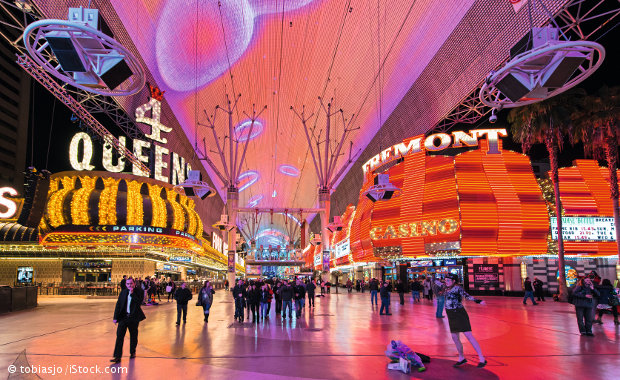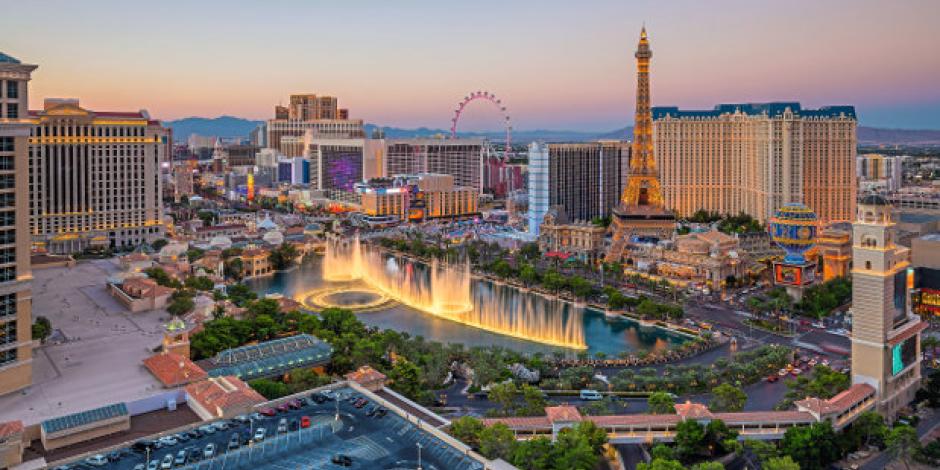Day 1
Arrival — 8:30 p.m.
I fly under a sea of lights through the heart of Downtown Las Vegas, one arm outstretched, in my best Supergirl pose. Tourists on the city’s oldest street stop to watch me fly over their heads. Most of them are preoccupied by the other spectacles: singers, dancers, artists, tarot-card readers, and historic casinos promising cheap beer and cash prizes. I am on the SlotZilla Zoomline, a slot-themedthematisch ausgerichtet auf Spielautomatenslot-themed attraction that travels the length of the Fremont Street Experience at more than 35 miles an hour (56 kph).
Back on the ground, I mix with the other tourists enjoying the Fremont Street Experience, a five-block area under a canopyÜberdachungcanopy in the form of a big barrel vault that comes alive every hour with a spectacular light and sound show. People at stallVerkaufsstandstalls try to sell me Vegas shirts and three-foot-tall margarita glasses, while imitators of Elvis Presley and Frank Sinatra, showgirls in feathered headdresses, and shirtless, muscled men in a Chippendales dancers’ boothStandbooth compete for my attention.
I go into the Golden Gate Hotel, home to the city’s oldest casino — and a permanent cloud of smoke. Here in Vegas, you can smoke inside casinos and, unlike most of the US, drink on the street. As the sight of a woman in a wedding dress throwing a pair of diceSpielwürfeldice across a table reminds me, you can get married on a whimaus einer Laune herauson a whim, too. I follow a cocktail waitress between rows of slot machines as she offers free drinks to players. Then I put a dollar into a machine and press the button. Maybe this will be my lucky night.
The SlotZilla Zoomline. Source: YouTube
Day 2 — 9 a.m.
Long before the first casino opened in Las Vegas in 1931, people were coming to the area hoping to to strike it richplötzlich reich werdenstrike it rich by discovering silver and gold. I leave Las Vegas and drive south through the Mojave Desert. As I look out at the dry land and stony mountains, I imagine what life must have been like for those early prospectorSchürfer, Goldgräberprospectors. Many of them left their homes and traveled thousands of miles to get here, North America’s driest desert, which offers little shelter from the harshrauharsh weather and few sourceQuellesources of water or food.
From around the mid 1800s to the mid 1900s, the Techatticup Mine was the biggest and most productive gold mine in the Colorado Mining District. Today, it is a tourist attraction, operated by Eldorado Canyon Mine Tours. I arrive in time for the 10 a.m. tour and, with about a dozen other tourists, leave the bright sunlight and step into the mine’s dark, cool tunnels. We follow our guide, Bruce, along narrow passages lit by lanternLaternelanterns. He points out the quartz veinQuarzaderquartz veins that once contained gold and silver, and he tells us stories of courage, hardshipMühsal, Nothardship, and corruption. When we’re deep in the mine, he switches off the lanterns to show us what it was like for miners who got trappedeingeschlossentrapped here. I have never seen such darkness. It’s so intense that, when I hold my hand in front of my face, I see nothing.
Happy to be back in the sunlight, I pass by what looks like an airplane wreck — a propRequisiteprop from a movie, in fact — before crossing the road to a to restorewieder aufbauenrestored mining town. The main attraction here is the general storeGemischtwarenladengeneral store, which is full of relicRelikt, Überrestrelics from the past. I stop outside to photograph a mummifiedmumifiziertmummified cat and pose at a rusty old piano. Then, on Bruce’s recommendation, I drive a few miles east to a Colorado River overlook and sit by the edge of a cliff to eat a sandwich and watch people kayaking in the blue waters below.
12:30 p.m.
I arrive at the office of Flightlinez Bootleg Canyon, 30 minutes north of Techatticup Mine, in Boulder City. This is the place to go if you want to zoomsausen, rasento zoom across the Mojave Desert on four different zip lineSeilrutschezip lines. First, there’s a training lesson, during which we learn where to position our hands and how to use our brakeBremsebrakes, for example. Then 11 of us, with helmetHelmhelmets and harnessGurtzeugharnesses, follow our four tour guides onto a minibus.
“The bus ride is the scaryfurchterregend, beängstigendscariest part of the day,” jokes our guide Scho — except that he’s not really joking. The bus leaves the pavedbefestigt, geteertpaved road and climbs a narrow path up the edge of a mountain, navigating hairpin turnHaarnadelkurvehairpin turns and steepsteilsteep dropHöhenunterschieddrops. I’m afraid to look out the window. Fortunately, our tour guides keep us laughing all the way with a well-practiced comedy routine.
When we get off the bus, we take a few minutes to enjoy the endless desert landscape and blue skies. From here, it’s a short hikeWanderunghike to the first zip line. My heart starts to beat faster when I see it. I can’t believe how long and high it is. Between them, the four zip lines cover more than one and a half miles (2.4 km). I sit in the harness, and Kenna, the guide, reminds me what to do. “Are you ready?” she asks. Then she releases my harness, and away I go, zooming through the air, hundreds of feet above the ground and at up to 60 miles an hour (100 kph).
5 p.m.
Boulder City is a few miles from the Colorado River, Lake Mead, and Hoover Dam, which are all connected to each other and, in turnwiederum, seinerseitsin turn, to Las Vegas. About 25 miles (40 km) southeast of Vegas, the Colorado River widens into Lake Mead, which was formed by Hoover Dam and has a greater water capacity than any other reservoir in the US. Hoover Dam was built between 1931 and 1936, and led to the formation of Boulder City, which housed the thousands of men who worked on this structure.
Although Las Vegas had existed since 1905, the arrival of the workers helped it survive the Great Depression of the 1930s and become the hotspot that it is today. Most of the construction workers were men away from their families. So the city began to open casinos and showgirl theaters to entertain the workers — a trend that earned it the title of “Sin City.”
Today, Hoover Dam is a popular tourist attraction, visited by more than a million people every year, and I can see why. I walk across this concreteBeton-concrete wonder, looking down at the depletingallmählich sinkenddepleting waters of Lake Mead. This reservoir supplies water to almost 20 million people in three states. But because of droughtDürre, Trockenheitdrought and demandBedarfdemand, it hasn’t been full since the early 1980s, and it is now at only about 40 percent of its capacity. After walking the length of it, from Nevada to Arizona and back again, I drive to the Mike O’Callaghan-Pat Tillman Memorial Bridge, the newest structure. At 900 feet (270 m) above the Colorado River, this is the world’s highest concrete arch bridgeBogenbrückearch bridge. I climb about 70 steps to reach it and then walk to its middle point to watch the sun set and the dam, this marvelWunder(werk)marvel of man and nature, light up below.
Day 3 — 10 a.m.
The Fremont Street Experience opened in 1995 to attract tourists, but there’s a lot more to Downtown Vegas than this area. I wander through the 18 blocks of the Las Vegas Arts District, better known as 18b, passing second-hand clothing boutiques, antique stores, art galleries, and restaurants. Many of the buildings have bright, beautiful muralWandgemäldemurals, and there are some fantastic art installations, including a heartshaped sculpture and an enormous praying mantrisGottesanbeterinpraying mantis that breathes fire.
Many of Downtown’s most popular attractions opened in 2012, known as “The Year of Downtown.” They include the Smith Center for the Performing Arts, the Discovery Children’s Museum, and the Neon Museum, at which I’ve joined a one-hour tour of the Neon boneyardFriedhofBoneyard. Normally, things go to the boneyard when they die, but here, the old neon signs of Vegas are given new life. The museum is home to almost 250 signs that once belonged to local hotels, casinos, bars, and wedding chapels. My favorite is from the Stardust, a famous resortFerienort; hier: Hotelresort on the Las Vegas Strip that was torn down in 2007. “Stardust” is spelled out in enormous red letters that once stood on top of its casino and could be seen up to 60 miles away.
1 p.m.
My next visit is to the Mob Museum, which also opened in 2012 and is inside a 1930s’ building that was once the Las Vegas Post Office and Courthouse. This museum tells the story of organized crime in the US through exhibitAusstellungsstückexhibits on three floors. You can experience life on both sides of the law by taking part in a lineupGegenüberstellunglineup, using real FBI surveillance equipmentÜberwachungsanlagesurveillance equipment, and listening to recorded wiretapWanze, Abhörgerätwiretaps.
One of the most popular exhibits is the St. Valentine’s Day Massacre Wall, the wall where members of Bugs Moran’s gang were shot in Chicago, allegedlyangeblichallegedly by Al Capone’s gang, on Valentine’s Day in 1929. I wander into the courtroomGerichtssaalcourtroom on the second floor just in time for a multimedia show about an important Mob(amerikanische) MafiaMob hearingAnhörunghearing that took place here and in other courtrooms across the US in the early 1950s. I feel as if I’m part of mobsterMafioso-mobster history.
I’m especially interested in exhibits about the connection between organized crime and Las Vegas. As the museum’s senior director of content, Geoff Schumacher, explains to me, organized-crime figureVerbrecher, Gangstercrime figures built some of the early resorts that exist today. The most famous of these may be the Flamingo, which Bugsy Siegel opened on the Strip in 1946, six months before his business partners murdered him on suspicion of fraudBetrugsverdachtsuspicion of fraud. Most, if not all, of these crime figures operated their casinos illegally. From around the 1970s on, they were bought out by legitimate investors, resulting in the model of corporate-ownedunternehmenseigencorporate- owned resorts that we know today.
4 p.m.
It’s a funny fact that what most people think of as Las Vegas isn’t actually in Las Vegas. The Strip, a section of Las Vegas Boulevard that is just over four miles long (6.8 km) and linedgesäumtlined with toweringhoch aufragendtowering megaresorts is actually south of Las Vegas, in two unincorporatedgemeindefreiunincorporated towns. As I drive along it with my windows open, however, I feel as if I’m on a global adventure. There’s the volcano at the Mirage — the Strip’s first megaresort, which Steve Wynn opened in 1989, to heraldankündigen, einläutenheralding a new era of luxury. There’s the “Eiffel Tower Experience,” which is an imitation Eiffel Tower with observation deckAussichtsplattformobservation deck at the Paris Las Vegas Hotel & Casino, and there are the dancing fountains at the Bellagio, and the glass pyramid that is the Luxor.
After driving along the Strip, I decide to walk along it, only to discover that the megaresorts are a lot further away from each other than they look. Fortunately, many of them are connected by free trams and pedestrianFußgänger-pedestrian bridges, one of which I follow into the MGM Grand. The world’s biggest hotel complex when it opened in 1993, the MGM has five outdoor pools, rivers, waterfalls, boutiques, restaurants, and a luxury spaWellness-Einrichtungspa. I walk through its casino, which is so well ventilated that I hardly notice the smoke, and into its steampunk-themed theater for the 7 p.m. showing of Ka. This coming-of-ageEntwicklungs-coming-of-age story is one of several Cirque du Soleil productions on the Strip, and it is told with the help of enormous moving platforms and fantastic visual effects. The performers dance, fight, and fly through the air. I’m totally blown away by the spectacle.
Day 4
Departure — 11 a.m.
It’s time to leave this crazy, wonderful city, but before I do, I have time for one more stop, at Dig This, which is a few minutes from the Strip. Wearing a hard hatSchutzhelmhard hat and vestWestevest, I follow my instructor, Josh, onto a five-acreMorgen (4.047 m2)acre sandpitSandgrubesandpit, where you can drive enormous machines just for fun. Nervously, I climb into the cab of a mini-excavatorBaggerexcavator. There are full-sized excavators, as well as bulldozers and skid steerKompaktladerskid steers, but this one is big enough for me.

If you go
Getting there
Fly to McCarran International Airport (LAS), www.mccarran.com
What to do
- Go zip lining in the Mojave Desert with Flightlinez Bootleg Canyon. www.flightlinezbootleg.com
- Visit the Mob Museum in Downtown Las Vegas. themobmuseum.org
- See a Cirque du Soleil show. www.cirquedusoleil.com/las-vegas
- Book a session with Dig This. digthisvegas.com
More information
www.lvcva.com
Neugierig auf mehr?
Dann nutzen Sie die Möglichkeit und stellen Sie sich Ihr optimales Abo ganz nach Ihren Wünschen zusammen.



